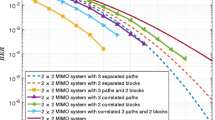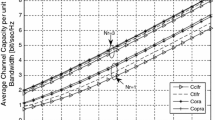Abstract
We consider turbo-trellis-coded transmission over fading multiple-input-multiple-output (M1M0) channels with transmit diversity using space-time block codes. We give a new view on space-time block codes as a transformation of the fading MIMO channel towards a Gaussian single-input-single-output (siso) channel and provide analytical results on the BER of space-time block codes. Furthermore, we describe the concatenation of Turbo-TCM with a space-time block code and show that in addition to the transmit diversity substantial benefits can be obtained by turbo iterations as long as the channel is time-varying during transmission of a coded block or frequency hopping is applied. Finally, a double iterative scheme for turbo equalization and turbo decoding of the concatenation of Turbo-TCM and space-time block code in frequency-selective MIMO channels is described.
Résumé
Nous considérons une transmission codée en treillis de type turbo sur des canaux à évanouissements multi-entrées multi-sorties (MIMO), utilisant une diversité d’émission réalisée par des codes en blocs spatio-temporels. Nous proposons une nouvelle conception des codes en blocs spatio-temporels comme une transformation du canal MIMO à évanouissements en un canal de Gauss mono-entrée mono-sortie et nous fournissons des résultats analytiques sur les taux d’erreurs binaires des codes en blocs spatiotemporels. De plus, nous décrivons la concaténation d’une modulation codée en treillis de type turbo et d’un code en bloc spatio-temporel et nous montrons qu ’en plus de la diversité d’émission, des gains non négligeables peuvent être obtenus par des itérations turbo, tant que le canal varie dans le temps durant la transmission d’un bloc codé ou qu’un saut de fréquence est appliqué. Enfin, un schéma doublement itératif pour la turbo égalisation et le turbo décodage de la concaténation d’une modulation codée en treillis de type turbo et d’un code en bloc spatio-temporel sur des canaux MIMO sélectifs en fréquences est décrit.
Similar content being viewed by others
References
Alamouti (S.), “A simple transmitter diversity technique for wireless communications,” IEEE Journal on Selected Areas of Communications, Special Issue on Signal Processing for Wireless Communications, 1998.
Tarokh (V.), Jafarkhani (H.), Calderbank (A.R.), “Space-time block codes from orthogonal designs,”ieee Transactions on Information Theory, vol. 45, no 5, pp. 1456–1467, June 1999.
Robertson (P.), Wörz (T.), “A novel bandwidth efficient coding scheme employing turbo codes”, in International Conference on Communications (ice),ieee, 1996, pp. 962–967.
Foschini (G.T), Gans (M.J), “On limits of wireless communications in a fading environment when using multiple antennas,”Wireless Personal Communications, vol. 6, pp. 311–335, 1998.
Telatar (E.), Tse (D.N.C.), “Capacity and mutual information of wideband multipath fading channels,”ieee Transactions on Information Theory, vol. 46, no 4, pp. 1384–1400, July 2000.
Foschini (G.J.), “Layered space-time architecture for wireless communication in a fading environment when using multiple antennas,“Bell Labs Technical Journal, vol. 1, Nr.2, pp. 41–59, 1996.
Bäro (S.), Bauch (G.), Pavlic (A.), Semmler (A.), “Improving blast performance using space-time block codes and turbo decoding,” ingLObecom 2000. ieee, November 2000, pp. 1067–1071.
Bjerke (B.A), Proakis (J.G.), “Multiple-antenna diversity techniques for transmission over fading channels,“ inWireless Communications and Networking Conference (wcnc), September 1999, vol. 1, pp. 261–265.
Tarokh (V.), Jafarkhani (H.), Calderbank (A.R.), “Space-time block coding for wireless communications: Performance results,”ieee Transactions on Information Theory, vol. 17, no 3, pp. 451–460, March 1998.
Radon (J.), “Lineare Scharen orthogonaler Matritzen,”Abhandlungen aus dem Mathematischen Seminar der Hamburgischen Universitat, vol. I, no 2, pp. 1–14, 1922.
Tirkkonen (O.), Hottinen (A.), “Complex space-time block codes for four tx antennas,” in gwbecom, ieee, November/December 2000, pp. 1005–1009.
Proakis (J.G.),Digital Communications, McGraw Hill, New York, third edition, 1995.
Proakis (J.G.), “Probabilities of error for adaptive reception of m-phase signals,”ieee Transactions on Communications, vol. com-16, pp. 71–81, February 1968.
Kammeyer (K.),Nachrichteniibertragung, Informationstechnik. Teubner, Stuttgart, second edition, 1996, (in German).
Jamali (S.H.), Le-Ngoc (T.),Coded-Modulation Techniques for Fading Channels, Kluwer Academic Publishers, Boston, 1994.
Schlegel (C), Costello (D.J.), “Bandwidth efficient coding for fading channels: Code construction and performance analysis,”ieee Journal on Selected Areas in Communications, vol. SAC-7, pp. 1356–1368, December 1989.
Le Goff (S.), Glavieux (A.), Berrou (C), “Turbo-codes and high spectral efficiency modulation,” in International Conference on Communications (ice),ieee, May 1994, pp. 645–649.
Bahl (L.R.), Cocke (J.), Jelinek (F), Raviv (J.), “Optimal decoding of linear codes for minimizing symbol error rate,”ieee Transactions on Information Theory, vol. IT-20, pp. 284–287, March 1974.
Douillard (C), Jézéquel (M.), Berrou (C), Picart (A.), Didier (P.), Glavieux (A.), “Iterative correction of intersymbol interference: Turbo-equalization,”European Transactions on Telecommunications, vol. 6, no 5, pp. 507–511, September- October 1995.
Bauch (G.), Khorram (H.), Hagenauer (J.), “Iterative equalization and decoding in mobile communications systems,” in The Second European Personal Mobile Communications Conference (2.epmcc’97) together with 3. ITG-Fachtagung “Mobile Kommunikation ”. vde/ttg, September/October 1997, pp. 307–312.
Alamouti (S.), Tarokh (V.), Poon (P.), “Trellis-coded modulation and transmit diversity: Design criteria and performance evaluation, ” in icvpc, October 1998.
Bauch (G.), Al-Dhahir (N.), “Iterative equalization and decoding with channel shortening filters for space-time coded modulation, ” inieee Vehicular Technology Conference (VTC), September 2000, pp. 1575–1582.
Bauch (G.), Al-Dhahir (N.), “Reduced-complexity turbo equalization with multiple transmit and receive antennas over multipath fading channels,” in Conference on Information Sciences and Systems (ass), March 2000, pp. wp3-13-wp3-18.
Bauch (G.), “Concatenation of space-time block codes and “turbo”-TCM," in International Conference on Communications (ice), ieee, June 1999, pp. 1202-1206.
Bäro (S.), Bauch (G.), Hansmann (A.), “Improved codes for space-time trellis coded modulation,”ieee Communications Letters, vol. 4, no 1, pp. 20–22, January 2000.
Bauch (G.), Franz (V.), “A comparison of soft-in/soft-out algorithms for “turbo-detection”,” in International Conference on Telecommunications (ict), June 1998.
Berrou (C), Glavieux (A.), Thitimajshima (P.), “Near shannon limit error-correcting and decoding: Turbo-codes (1),” in International Conference on Communications (icc), ieee, May 1993, pp. 1064–1070.
Bauch (G.), Naguib (A.), Seshadri (N.), “map equalization of space-time coded signals over frequency selective channels,” in Wireless Communications and Networking Conference (wcnc), September 1999.
Glavieux (A.), Laot (C), Labat (J.), “Turbo-equalization over a frequency selective channel,” in International Symposium on Turbo Codes, enst de Bretagne, September 1997, pp. 96–102.
Hagenauer (J.), “The turbo principle: Tutorial introduction and state of the art,” in International Symposium on Turbo Codes, enst de Bretagne, September 1997, pp. 1–11.
Hagenauer (J.), Offer (E.), Papke (L.), “Iterative decoding of binary block and convolutional codes,”ieee Transactions on Information Theory, vol. IT-42, pp. 425–429, March 1996.
Picart (A.), Didier (P.), Glavieux (A.), “Turbo-detection: A new approach to combat channel frequency selectivity,” in International Conference on Communications (icc), ieee, June 1997, pp. 1498–1502.
Robertson (P.), “An overview of bandwidth efficient turbo coding schemes,” in International Symposium on Turbo Codes, 1997, pp. 103-110.
Robertson (P.), Worz (T.), “Coded modulation scheme employing turbo codes,”Electronic Letters, vol. 31, no 18, pp. 1546–1547, August 1995.
Robertson (P.), Wörz (T), “Extensions of turbo trellis coded modulation to high bandwidth efficiencies,” in International Conference on Communications (icc),ieee, 1997, pp. 1251–1255.
Raphaeli (Y.), und Zarai (D.), “Combined turbo equalization and turbo decoding,” in International Symposium on Turbo Codes, 1997, pp. 180–183.
Tarokh (V.), Naguib (A.), Seshadri (N.), Calderbank (A.R.), “Space-time codes for high data rate wireless communication: Performance criteria in the presence of channel estimation errors, mobility and multiple paths,”ieee Transactions on Communications, vol. 47, no 2, pp. 199–207, February 1999.
Wittneben (A.), “A new bandwidth efficient transmit antenna modulation diversity scheme for linear digital modulation,” in International Conference on Communications (icc), ieee, 1993, pp. 1630–1633.
Author information
Authors and Affiliations
Corresponding authors
Rights and permissions
About this article
Cite this article
Bauch, G., Hagenauer, J. & Seshadri, N. Turbo processing in transmit antenna diversity systems. Ann. Télécommun. 56, 455–471 (2001). https://doi.org/10.1007/BF02995456
Received:
Accepted:
Issue Date:
DOI: https://doi.org/10.1007/BF02995456
Key words
- Mobile radiocommunication
- Space diversity
- Block code
- Fading
- Concatenation
- Coded modulation
- Treillis coding
- Turbo code




